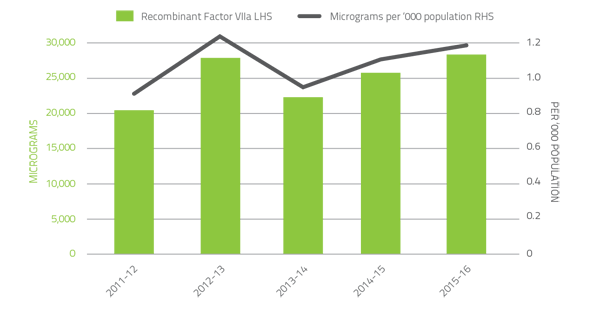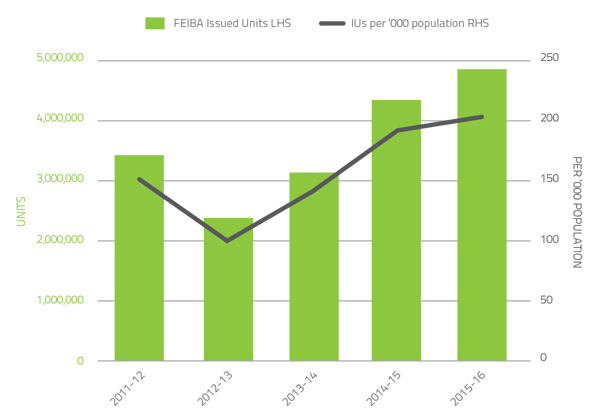Objective 1. Secure the supply of blood and blood products
It is the responsibility of the National Blood Authority (NBA) to manage the national blood supply to ensure that healthcare providers have sustainable, reliable and efficient access to blood and blood products needed for patient care. NBA ensures blood supply security by working with states and territories to determine and manage an annual supply plan and budget and negotiating and managing blood supply contracts and arrangements with local and overseas suppliers.
National Supply Plan and Budget
A key element of the NBA's role in ensuring security of supply is to develop, coordinate and monitor the annual National Supply Plan and Budget (NSP&B), including obtaining annual approval from health ministers.
This is achieved by:
- developing a national estimate of product demand
- liaising with states and territories to refine the estimated demand for products
- collecting and distributing data on product issued and reporting variations to jurisdictions on the approved supply plan
- intensively managing products if they are in short supply.
Performance against the 2015–16 NSP&B
Throughout 2015–16, products were supplied to meet clinical demand and supply risks were effectively managed. The approved budget for 2015–16 covering the supply and management of blood and blood products and services under contract was $1,166.40 million, comprising $627.89 million for fresh blood products and plasma collection (see Fresh blood products on p.27) and $520.33 million for plasma and recombinant products (see Plasma and recombinant products on p.30). The remaining $18.18 million included items such as support for the publication of PBM Guidelines, maintenance of the Australian Haemophilia Centre Directors' Organisation (AHCDO) and administration of the Australian Bleeding Disorders Registry (ABDR). Table 2.1 identifies the NBA's expenditure in 2015-16 and earlier years by supplier for the supply of products in each product category.
TABLE 2.1 Blood and blood products purchased, by supplier, 2010-11 to 2015-16.
| Supplier | Products Purchased | 2010‑11 ($M) |
2011‑12 ($M) |
2012‑13 ($M) |
2013‑14 ($M) |
2014‑15 ($M) |
2015‑16 ($M) |
|---|---|---|---|---|---|---|---|
|
CSL Behring (Australia) Pty Ltd |
Plasma Products
Diagnostic Reagent Products
Imported Plasma and Recombinant Products
|
215.15 |
228.22 |
222.02 |
210.10 |
245.19 |
282.49 |
|
Australian Red |
Fresh Blood Products
|
496.57 |
526.35 |
549.31 |
583.13 |
547.10 |
588.40 |
|
Baxalta Australia |
Imported Plasma and Recombinant Products
|
96.93
|
45.95
|
6.301
|
8.25
|
29.11
|
36.62
|
Imported IVIg |
Nil | 7.37 | 26.76 | 29.20 | 40.30 | 28.35 | |
|
Bayer Australia Limited |
Imported Plasma and Recombinant Products
|
Nil |
11.30 |
34.96 |
35.14 |
9.00 |
1.07 |
|
Pfizer Australia Pty Ltd |
Imported Plasma and Recombinant Products
|
57.03 |
66.55 |
93.28 |
93.05 |
54.66 |
56.48 |
|
Novo Nordisk Pharmaceuticals |
Imported Plasma and Recombinant Products
|
27.37 |
24.55 |
33.60 |
27.20 |
32.81 |
36.39 |
|
Octapharma Pty Ltd |
Imported IVIg |
8.95 |
23.38 |
49.10 |
46.00 |
70.02 |
47.05 |
|
Grifols Australia |
Imported IVIg Diagnostic Reagent Products
|
24.50 0.60 |
22.51 Nil |
0.28 Nil |
Nil 0.32 |
Nil 0.41 |
11.58 0.36 |
|
Ortho-Clinical Diagnostics (Johnson & Johnson Medical Pty Ltd) |
Diagnostic Reagent Products
|
0.38 |
0.45 |
0.44 |
0.43 |
0.44 |
0.43 |
|
Bio-Rad |
Diagnostic Reagent Products
|
Nil |
0.13 |
0.63 |
0.57 |
0.52 |
0.48 |
|
Abacus ALS Pty Ltd |
Diagnostic Reagent Products
|
0.03 |
0.05 |
0.04 |
0.04 |
0.00 |
0.00 |
|
Total Purchases of Blood and Blood Products |
927.51 |
956.81 |
1,016.72 |
1,033.43 |
1,029.56 |
1,089.70 |
|
1 In the 2012-13 annual report, Baxter Healthcare Pty Ltd imported Plasma and Recombinant Products figure of 33.06 included 6.30 Imported IVIg which has a category in subsequent reports. Care should be taken in making comparisons with previous reports.
2 With effect from 1 April 2015, all NBA contracts with Baxter Healthcare Pty Ltd were novated to Baxalta Australia Pty Ltd.
Throughout this report, references are made to Baxalta Australia Pty Ltd.
Fresh blood Products
The list of fresh blood products supplied in 2015-16 is at Appendix 2 Fresh blood components supplied under contract by the Blood Service. The four main products were:
- red blood cells
- platelets
- clinical fresh frozen plasma
- plasma for fractionation.
As demonstrated in Table 2.2, the increase in fresh blood expenditure has progressively moderated over the last 10 years primarily as a result of improved efficiencies in Blood Service operations, and in the last four years, a significant reduction in the demand for some fresh blood products due to improved appropriate use and reduced wastage.
TABLE 2.2 Fresh blood expenditure: increases over the last 10 years
| Year | Amount ($M) | Growth (%) |
|---|---|---|
| 2006-07 | 327.1 | 9.9 |
| 2007-08 | 369.1 | 12.8 |
| 2008-09 | 417.2 | 13 |
| 2009-10 | 456.1 | 9.3 |
| 2010-11 | 496.6 | 8.9 |
| 2011-12 | 526.3 | 6 |
| 2012-13 | 549.3 | 4.4 |
| 2013-14 | 583.1 | 6.2 |
| 2014-15 | 547.1 | -6.2 |
| 2015-16 | 588.4 | 7.5 |
| Total | 4,860.3 | 7.2 (average) |
Fresh blood expenditure in 2015-16 compared to 2014-15 increased by 7.5 per cent. Key factors that have influenced the changes include the following:
- an increase in the quantity of collected plasma for fractionation from 572 tonnes to 601 tonnes
- restrained annual price indexation to 2.95 per cent
- reduction in demand for some fresh products as a result of improved appropriate use and reduced wastage.
Since the implementation of the Output Based Funding Model (OBFM) in 2010-11 where governments paid for the actual costs of producing fresh blood products supplied by the Blood Service rather than a grant based funding model, we have seen an increase in returns to government year on year as highlighted in Figure 2.1. In 2015-16 $63.1 million was returned including $42.4 million for the Blood Service operating surplus and a saving from the decrease in red blood cell demand of 3.4 per cent. This compared to $66.2 million in 2014-15 (which included $28.5 million operating surplus and 5 per cent reduction in red blood cell demand). The Blood Service also provided savings of $18.5 million in the pricing for plasma for fractionation in 2015-16 compared to $12 million in 2014-15.
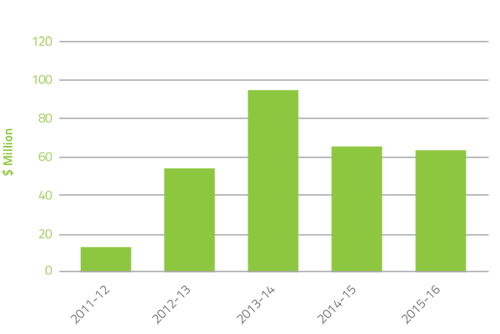
FIGURE 2.1 Returns to Government 2011-12 to 2015-16
Red blood cells
Red blood cells comprise approximately 22.9 per cent of total blood and blood product expenditure and are the largest item of cost in fresh products. Figure 2.2 illustrates that there was a decline in issues of red blood cells (3.4 per cent) compared to 2014-15, with continuation of the steady decline in issues per 1,000 head of population nationally from 35.6 in 2011-12 to 27 in 2015-16. In the last four years, demand for red cells has declined by over 21 per cent, realising a saving in excess of $94 million. The decline in red cell demand is the result of the ongoing success of programs to improve appropriate use and reduce wastage. These programs encompass a range of health provider and clinical engagement activities, development of best practice guidelines and tools, improved data collection and analysis and improved education and training arrangements. The publication and implementation of the PBM Guidelines underpins much of the success in improving appropriate use of fresh blood products.
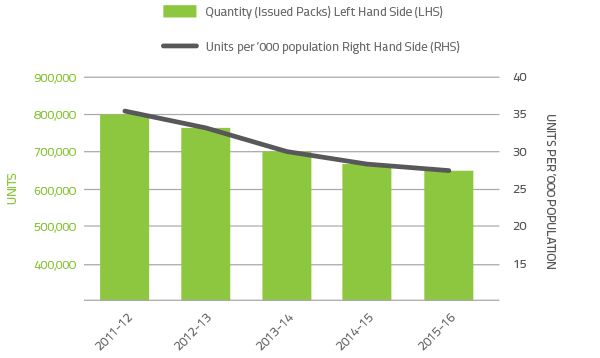
FIGURE 2.2 Red Cells issued by the Blood Service and per '000 population
Platelets
Platelets comprise 5.5 per cent of total blood and blood product expenditure. Figure 2.3 illustrates that there was a small increase in issues of platelets (1.8 per cent) from 2014-15 and a small increase in issues per 1,000 head of population. Platelets are either derived from an apheresis collection or a whole blood collection. In 2015-16, platelets issued were 65.0 per cent whole blood pooled (64.2 per cent in 2014-15) and 35.0 per cent apheresis (35.8 per cent in 2014-15).
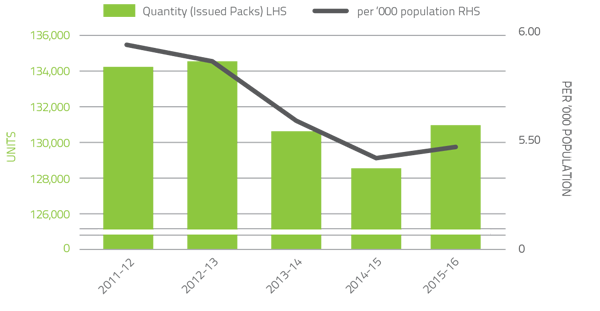
FIGURE 2.3 Platelets issued by the Blood Service and per '000 population
Plasma for fractionation
The Blood Service collects plasma for fractionation to supply to CSL Behring (Australia) Pty Ltd for the manufacture of plasma derived products. In 2015-16, the target for the quantity of plasma to be collected by the Blood Service was 601 tonnes, which the Blood Service successfully achieved. The growth in apheresis plasma collection by the Blood Service over the last five years is shown in Figure 2.4 below. In 2010-11 the ratio of whole blood to apheresis plasma for fractionation was 50:50 and in 2015-16 29:71. This is in part due to the decline in red blood cell demand.
The growth in plasma collection for 2015-16 is consistent with governments' target of 5 per cent per annum.
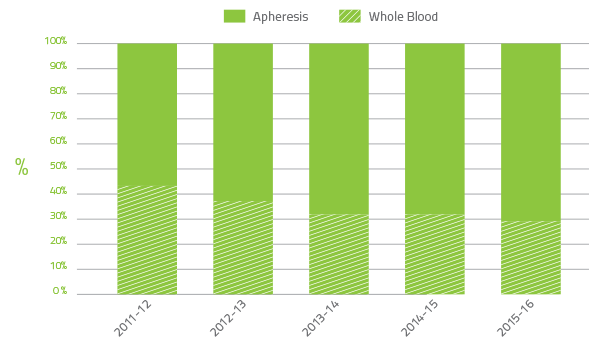
FIGURE 2.4 Whole blood to apheresis plasma for fractionation 2011-12 to 2015-16
Plasma and recombinant products
The cost of plasma derived and recombinant blood products issued under NBA arrangements in 2015-16 totalled $504.09 million, an increase of $26.9 million (5.6 per cent) from 2014-15. Increases in volumes for immunoglobulin (Ig), 12.4 per cent, and Recombinant Factor VIIa, 9.5 per cent, were the dominant factors relating to the growth in expenditure. Conversely, there were cost reductions in recombinant factors VIII and IX following a highly successful tender process undertaken in 2014 that resulted in lower prices for these products. The cost of most other products increased by less than 2 per cent. The average unit price for domestically produced IVIg decreased by 0.7 per cent due to the favourable price structure under the CSL Australian Fractionation Agreement (CAFA) in which price decreases with increases in volume.
In the 10 years to 2015-16, expenditure on plasma and recombinant products issued under NBA arrangements has increased from $205.2 million to $504.09 million. Key drivers of this increase are:
- $315.4 million from increased demand
- $51.8 million due to the safety based government policy decision to fund recombinant clotting factor products (rFVIII and rFIX).
The combined effect of demand and price drivers on expenditure can be seen in Figure 2.5. It is of note that significant improvements in price have driven a large increase in savings.
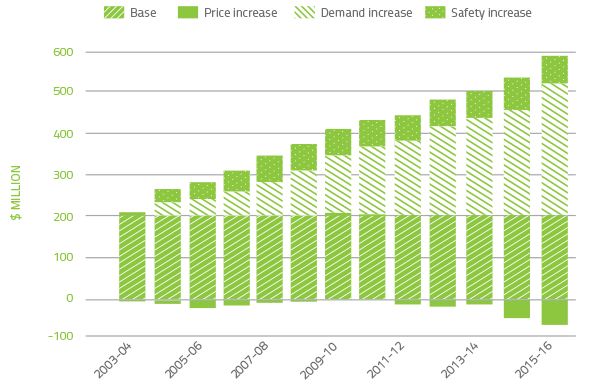
FIGURE 2.5 Plasma derived and overseas product expenditure: cumulative increases on 2003-04 base year
Issues of clotting factors
In 2015-16 clotting factors comprised 15.5 per cent of total blood and blood product expenditure. Figure 2.6 indicates that the demand for Factor VIII products increased by 5.0 per cent when compared to 2014-15. The relative proportion of recombinant versus plasma derived product remains stable. Plasma derived Factor VIII is an important alternative for immune tolerisation therapy and von Willeband disease (vWD). The demand for recombinant Factor VIII increased by 5.2 per cent over 2014-15. Plasma derived Factor VIII demand increased by 3.1 per cent.
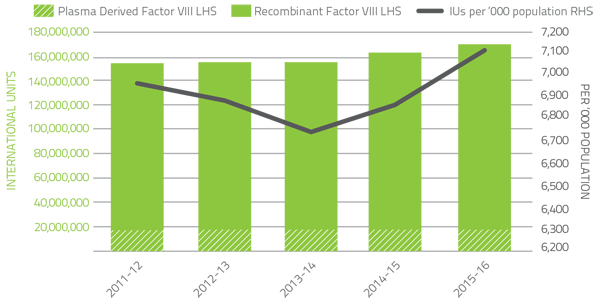
FIGURE 2.6 Issues of Factor VIII products 2011-12 to 2015-16 per '000 population
Figure 2.7 indicates that demand for Factor IX products in 2015-16 increased by 2.7 per cent compared to 2014-15. Plasma derived Factor IX demand decreased by 61.4 per cent in 2015-16 due to a reduction in specific patient requirements. Demand for Recombinant Factor IX increased by 8.0 per cent in 2015-16. The increased demand was largely driven by increases in surgeries.
Patient participation in company clinical trials for Extended Half Life recombinant Factor VIII and Factor IX products continues to contribute to the variability of year-to-year product growth.
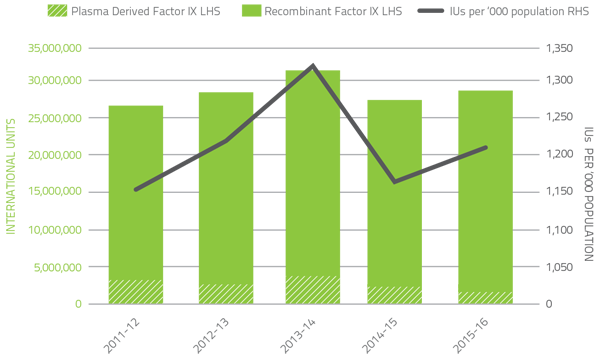
FIGURE 2.7 Issues of Factor IX products 2011-12 to 2015-16 per '000 population
The 2015-16 level of demand for Recombinant Factor VIIa increased by 9.5 and 11.8 per cent for FEIBA compared to 2014-15. Demand for Recombinant Factor VIIa and FEIBA can change significantly from year to year as a result of the variable needs of a small number of patients.
FIGURE 2.8 Issues of Factor VIIa products 2011-12 to 2015-16 per '000 population
FIGURE 2.9 Issues of FEIBA, 2011-12 to 2015-16 per '000 population
Issues of immunoglobulin: Ig and Normal Immunoglobulin (NIg)
As shown below demand for Ig continues to grow at a consistent annual rate of more than 10 percent.
| 2010-11 | 2011-12 | 2012-13 | 2013-14 | 2014-15 | 2015-16 |
|---|---|---|---|---|---|
| 11.1% | 10.9% | 10.7% | 11.0% | 10.2% | 12.4% |
In 2015-16, a total of 4.98 million grams of Ig was issued, representing a cost of $544.6 million nationally (including the cost of plasma collections). Of this amount, 57.2 per cent was Ig produced in Australia and 42.8 per cent was imported. Figure 2.10 highlights that the relative proportion of imported Ig compared to domestic Ig is growing at a rate of approximately 5 per cent per year over the last 5 years. This reflects the shortfall between the annual growth of domestic demand (approximately 11 per cent) and the annual growth of domestic plasma collection used to manufacture Ig (approximately 5 per cent).
Excluding Ig issued under direct orders, a total of 16,331 patients (compared with 14,983 in 2014-15) nationally were issued Ig during 159,041 treatment episodes (140,855 in 2014-15). Approximately 1.52 per cent of the issued Ig was subcutaneous Ig SCIg. SCIg was added to the National Supply List in September 2013.
An analysis of Ig use indicates that there are still considerable variations in the grams issued per treatment episode across jurisdictions for some conditions. Neurology remains the discipline using the greatest amount of Ig and demand is still increasing. Haematology is the next largest user of Ig but growth has slowed. A similar decline in growth has been observed in Immunology, the third largest user of Ig. The top three indications for Ig use are chronic inflammatory demyelinating polyneuropathy, common variable immunodeficiency disease and myasthenia gravis.
The NBA produced an annual report of Ig usage in 2014-15, to document trends in Ig use and provides insights into the drivers of use at the micro level.
The Report on the Issue and Use of IVIg 2014-15 can be found on the NBA website at https://www.blood.gov.au/data-analysis-reporting.
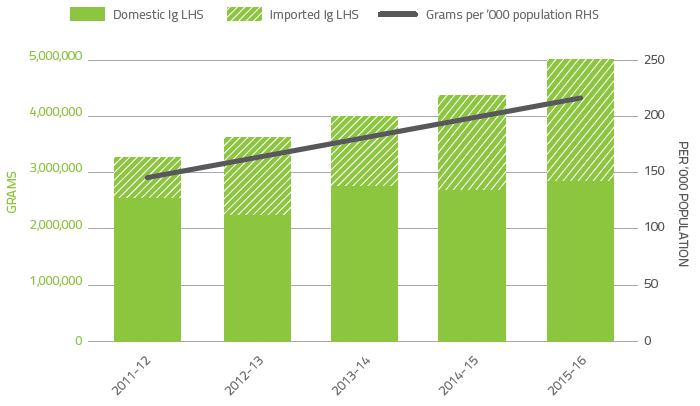
FIGURE 2.10 Issues of Ig products, 2011-12 to 2015-16 per '000 population
Contract Management
Maintaining security of supply requires the NBA to manage contracts with suppliers of blood and blood products. Contracts are developed in accordance with the Commonwealth Procurement Rules, and managed in accordance with Best Practice Guidance for contract management, including the guideline from the Australian National Audit Office (ANAO) on Developing and Managing Contracts.
In 2015-16 the NBA managed 16 blood and blood product supply contracts and arrangements.
The contracts managed by the NBA included:
- fresh blood product procurement - Australia's fresh blood component requirements through the Deed of Agreement with the Australian Red Cross Society
- plasma and recombinant product procurement - Australia's plasma product and recombinant product requirements through:
- the CSL Australian Fractionation Agreement (CAFA)
- contracts for the provision of imported IVIg, imported recombinant factors VIIa, VIII, IX, and XIII, and other imported plasma and recombinant products
- red cell diagnostic reagents products.
Deed of Agreement with the Red Cross
The Deed of Agreement with the Red Cross for the supply of fresh blood products by the Blood Service is one of the most important contracts managed by the NBA. The Blood Service is the sole supplier of fresh blood products. The provision of fresh blood products under the Deed is an essential clinical service that saves lives every day. The NBA has an ongoing program with the Blood Service to improve contract performance and accountability under the Deed. The NBA finalised the negotiations for a new nine year Deed of Agreement with the Red Cross – this represents the culmination of a number of years of collaborative work between Blood Service and NBA teams to work through all aspects of the service and funding arrangements. The new Deed was signed on 20 February 2016 for commencement 1 July 2016 and included a three year funding and service agreement.
Funding provided to the Blood Service is based on an OBFM arrangement. This was $588.4 million in 2015–16, an increase of $41.3 million over the $547.1 million provided in 2014–15.
Performance
The performance of the Blood Service is a key element in meeting blood sector objectives. Governments expect the Blood Service to deliver effective services at optimum value for money. Governments outline their expectations of the Blood Service in relation to performance through the Deed of Agreement and the Blood Service Statement of Expectations. Blood Service performance against selected indicators is outlined in Table 2.3.
TABLE 2.3 Blood Service: selected key performance indicators, 2015-16
| Domain | Indicator | 2014-15 result* | 2015-16 Blood Service target | 2015-16 result* | |
|---|---|---|---|---|---|
| Donor management | First time donors | Whole Blood | 88,528 | 115,527 | 94,220 |
| Apheresis Plasma | 31,336 | 40,336 | 46,619 | ||
| Supply chain management | Number of days within inventory bands (note: bands set by the Blood Service) | 330 | N/A | 339 | |
| Red cell yield (proportion of collections covered to supply) | 90.1% | 90.0% | 91.6% | ||
| Age of red cells at issue (days) | 6.8 | 8.0 | 6.85 | ||
| Order fulfilment red cells | 96.8% | N/A | 98.0% | ||
| Quality and level of service |
Health provider satisfaction with Blood Service (mean score out of 10) | 9.1 | 8.9 | 8.8 | |
| Finance | Main operating program financial result | $33.5 million surplus | >0 | $47.4 million surplus | |
* As measured by the Blood Service.
Implementing improvements to current arrangements
The NBA worked with the Blood Service to deliver a new Deed of Agreement to commence on 1 July 2016, including the following:
- the new Deed of Agreement signed on 20 February 2016, providing the legal framework for nine years
- a funding and service agreement that includes the third cycle of the Output Based Funding Model (OBFM) for 2016-19 and implementation of the National Service Requirements and Standards that set out the Blood Service's relationships with health providers and the NBA. This includes business rules and standards for ordering, delivery, and receipt of products
- implementation of the National Inventory Management Framework (NIMF) project for red blood cells, including proof of concept and a pilot for the NIMF for platelets.
Blood Service research and development
Through a grant specified in the Deed of Agreement, the Blood Service received grant funding of approximately $8.8 million for its research and development program. The Blood Service and the NBA negotiated a new Research and Development (R&D) Framework under the new Deed of Agreement arrangements to commence on 1 July 2016. In 2015-16 the Blood Service had four research programs:
- donor and community
- applied and developmental
- transfusion science
- clinical.
R&D business outcomes for the Blood Service were on track with 100 per cent of research projects completed in 2015-16 being translated into changed business practices or learnings. This year the Blood Service research inspired a new strategy to help first time donors manage their anxiety, explored methods to extend the shelf life of blood products, informed the risk management of Ross River Virus and tracked the fate of thousands of O negative blood units in the health system. Blood Service researchers have published 64 research papers in peer reviewed journals in 2015-16, continuing the significant growth in research output over the last five years.
CSL Australian Fractionation Agreement (CAFA)
Most plasma derived products used in Australia are manufactured by CSL Behring (Australia) Pty Ltd under the CAFA from plasma collected by the Blood Service. CSL Behring (Australia) Pty Ltd is the sole manufacturer of plasma derived blood products in Australia and the NBA is responsible for negotiating and managing the CAFA.
In 2015-16, 601 tonnes of Australian plasma was pooled for fractionation under the CAFA, and expenditure on CAFA products totalled $251.2 million.
Performance
The 2015-16 performance by CSL Behring (Australia) Pty Ltd against the CSL Australian Fractionation Agreement (CAFA) Key Performance Indicators (KPIs) is shown in Table 2.4. This table reports actual performance. Sufficient supply of all products was maintained at all times. The performance of CSL Behring (Australia) Pty Ltd was within defined tolerances for each of the KPIs with a few minor exceptions. Some approvals for KPI deviations were given by the NBA where known issues were beyond the control of CSL Behring (Australia) Pty Ltd, including changes in the level of Ig in plasma, and the dynamics of supply, demand and production for some products, which affected CSL Behring (Australia) Pty Ltd's ability to meet KPI standards.
TABLE 2.4 CSL Behring (Australia) Pty Ltd's performance under the CAFA, 2015-16
| Description of performance measure |
Results 2015-16 | |||||
|---|---|---|---|---|---|---|
| Q1 | Q2 | Q3 | Q4 | Annual | ||
| KPI1 | Plasma stewardship | Substantially Achieved* | Substantially Achieved* | Achieved** | Achieved | Substantially Achieved* |
| KPI2* | Production yield | 5.07g/kg | 4.99g/kg | 4.75g/kg | 4.88g/kg | 4.91g/kg |
| KPI3 | Management of required inventory levels | |||||
| Minimum starting plasma inventory | Not active in 2015-16 | |||||
| Products in CSL Behring (Australia) Pty Ltd inventory | 100% Achieved | 99.63% Achieved | 97.07% Achieved | 100% Achieved | 99.18% Achieved | |
| Products in national CSL Behring (Australia) Pty Ltd reserve | 100% Achieved | 100% Achieved | 100% Achieved | 100% Achieved | 100% Achieved | |
| KPI4 | Fulfilment of orders | |||||
| Orders by distributor (Blood Service) | 100% Achieved | 98% Achieved | 98.67% Achieved | 100% Achieved | 99.17% Achieved | |
| Orders by non-distributor |
100% Achieved | 100% Achieved | 100% Achieved | 100% Achieved | 100% Achieved | |
| KPI5** | Shelf life of national reserve products | 100% Achieved | 100% Achieved | 100% Achieved | 98.04% Achieved | 99.51% Achieved |
Note:
*In these instances, the performance of the relevant supplier departed from the contracted requirement at some periods during the year. Such instances were managed in discussions of supplier performance at regular contract management meetings.
** The NBA and CSL Behring (Australia) Pty Ltd are considering the effects of changes in plasma collection practices on CAFA contractual provisions relating to IVIg yield.
Imported Ig
Ig is imported to meet a shortfall in domestic Ig production against clinical demand in Australia. In addition to supply under the national blood arrangements, the NBA also supports the purchasing of small amounts of imported Ig using jurisdictional direct orders.
On 31 December 2015 two contracts for the supply of imported Ig expired. The suppliers were Baxalta Australia Pty Ltd and Octapharma Australia Pty Ltd.
In June 2015, the NBA successfully concluded a tender process for new contracts for the national supply of imported Ig to replace the current contracts which expired on 31 December 2015. The new contracts were awarded to CSL Behring Pty Ltd and Grifols Australia Pty Ltd. Total expenditure on imported Ig in 2015-16 amounted to $117.3 million.
Performance
The 2015-16 performance of all suppliers against the contractual KPIs is shown in Table 2.5. Sufficient supply of products was maintained at all times in accordance with contractual requirements and was not affected by transient or administrative KPI deviations.
TABLE 2.5 Imported IVIg: Key performance indicators, by supplier, 2015-16
| KPI | Performance | Octapharma Australia | Baxalta Australia Pty Ltd |
CSL Behring (Australia) Pty Ltd | Grifols Australia Pty Ltd |
|---|---|---|---|---|---|
| KPI1 | In-country reserve | Fully achieved | Fully achieved | Achieved* | Achieved* |
| KPI2 | Shelf life on products delivered |
Fully achieved | Fully achieved | Not achieved* | Not achieved* |
| KPI3 | Delivery performance | Fully achieved | Fully achieved | Achieved* | Achieved* |
| KPI4 |
Reporting accuracy and timeliness | Fully achieved | Fully achieved | Achieved* | Achieved* |
*In these instances, the performance of the relevant supplier departed from the contracted requirement at some periods during the transition of imported Ig Suppliers, without material effect on supply performance or supply security. Such instances were managed in discussions of supplier performance throughout the transition period.
Imported plasma derived and recombinant blood products
The NBA has contracts with suppliers for the importation of selected plasma derived and recombinant blood products to augment domestic supply where these products are not produced in Australia or domestic production cannot meet demand.
In 2015-16, the NBA managed the supply contracts for imported plasma and recombinant products with the following five companies:
- Baxalta Australia Pty Ltd
- Bayer Australia Ltd
- CSL Behring (Australia) Pty Ltd
- Novo Nordisk Pharmaceuticals
- Pfizer Australia Pty Ltd.
Procurement processes and contract negotiations were conducted during 2015-16 for contracts for the supply of Protein C, Activated Prothrombin Complex Concentrate, Factor XIII, Anti-Rh (D) and Fibrinogen Concentrate.
Expenditure on the above contracts in 2015-16 amounted to $131.2 million.
Performance
The 2015-16 performance of suppliers of imported plasma and recombinant blood products for each performance measure is shown in Table 2.6. All suppliers satisfactorily met required performance levels.
TABLE 2.6 Imported plasma and recombinant blood products: key performance indicators, by supplier, 2015-16
| KPI | Performance measure | Baxalta Australia (FEIBA/CEPROTIN) | Baxalta Australia (ADVATE/RIXUBIS) | Bayer Australia | CSL Behring (Australia) Pty Ltd | Novo Nordisk Pharmaceuticals | Pfizer Australia |
|---|---|---|---|---|---|---|---|
| KPI1 |
In-country reserve | Fully achieved | Fully achieved | Fully achieved | Fully achieved | Fully achieved | Fully achieved |
| KPI2 |
Shelf life on products delivered | Fully achieved | Not achieved* | Fully achieved | Fully achieved | Fully achieved | Fully achieved |
| KPI3 |
Delivery performance | Achieved** | Not achieved** | Fully achieved | Fully achieved | Fully achieved | Achieved* |
| KPI4 | Reporting accuracy and timeliness | Fully achieved | Fully achieved | Fully achieved | Fully achieved | Achieved* | Fully achieved |
*In these instances, the performance of the relevant supplier departed from the contracted requirement at some periods during the year, but without material effect on supply performance or supply security. Such instances are managed through prior approvals from the NBA, and discussion of supplier performance during the year.
** In these instances, the performance of the relevant supplier departed from the contracted requirement at some periods during the year. Performance of the relevant suppliers was nonetheless subject to contractual requirements and was managed through ongoing contract management monitoring. Where appropriate, financial consequences of not meeting contractual Key Performance Indicators were applied.
Red cell diagnostic reagent products
Red cell diagnostic reagents are used for testing to establish the blood group of human red cells, detect red cell antibodies and to control, standardise and validate routine haematology tests.
The NBA has established a standing offer arrangement with the following four suppliers for the period 1 July 2011 to 30 June 2016:
- Bio-RAD Laboratories Pty Ltd
- Grifols Australia
- Ortho-Clinical Diagnostics (Johnson & Johnson Medical Pty Ltd)
- Seqirus Pty Ltd.
The standing offer lists more than 100 red cell diagnostic products, which are used in laboratory tests known as blood typing and cross matching. These tests ensure that when a person needs a blood transfusion, they receive blood that is compatible with their own.
Expenditure on diagnostic reagent supply is capped at $4.85 million per year. The NBA manages the cap for all jurisdictions and suppliers.
The NBA completed a Request for Tender in June 2016 and a new standing offer arrangement will commence with the above Suppliers from 1 July 2016.

